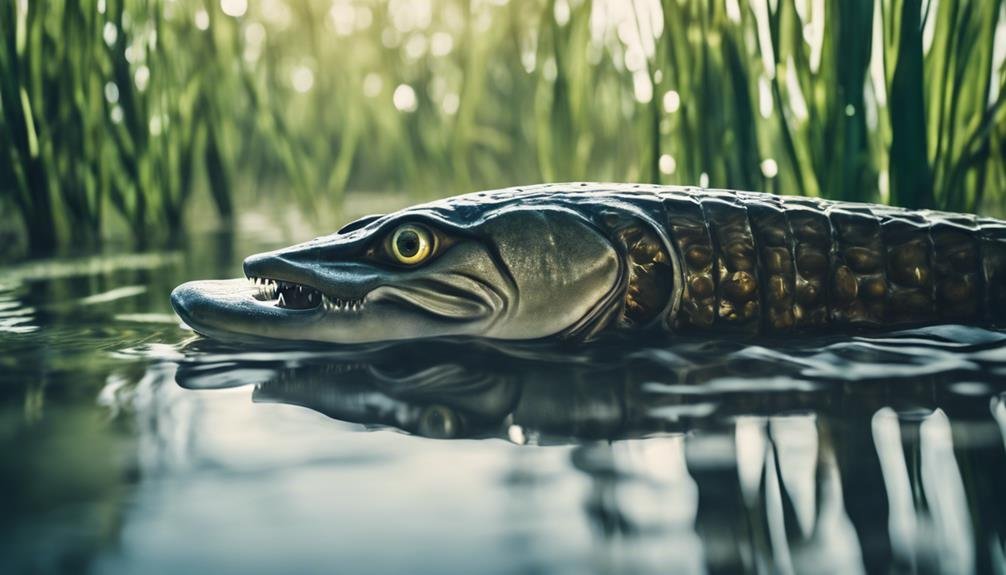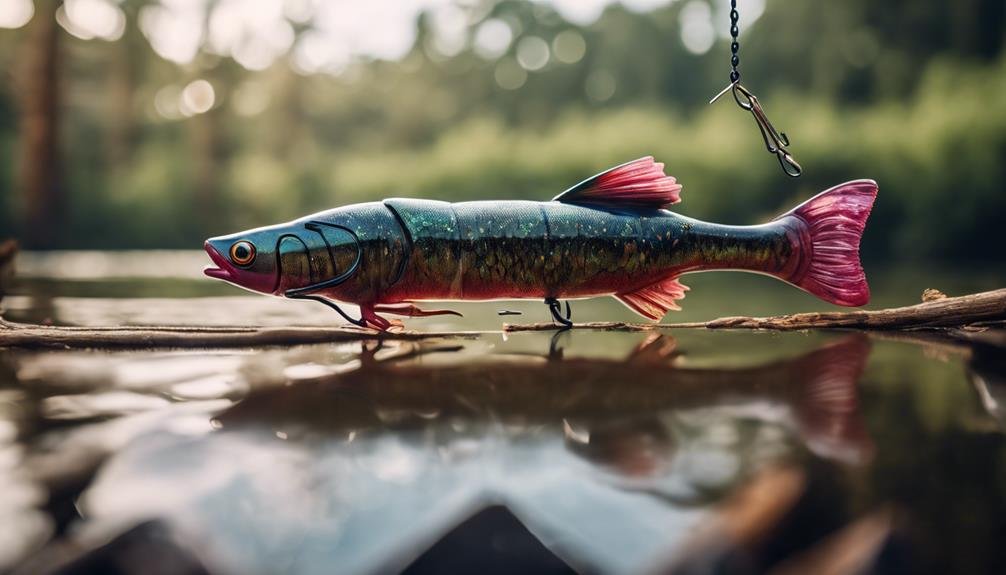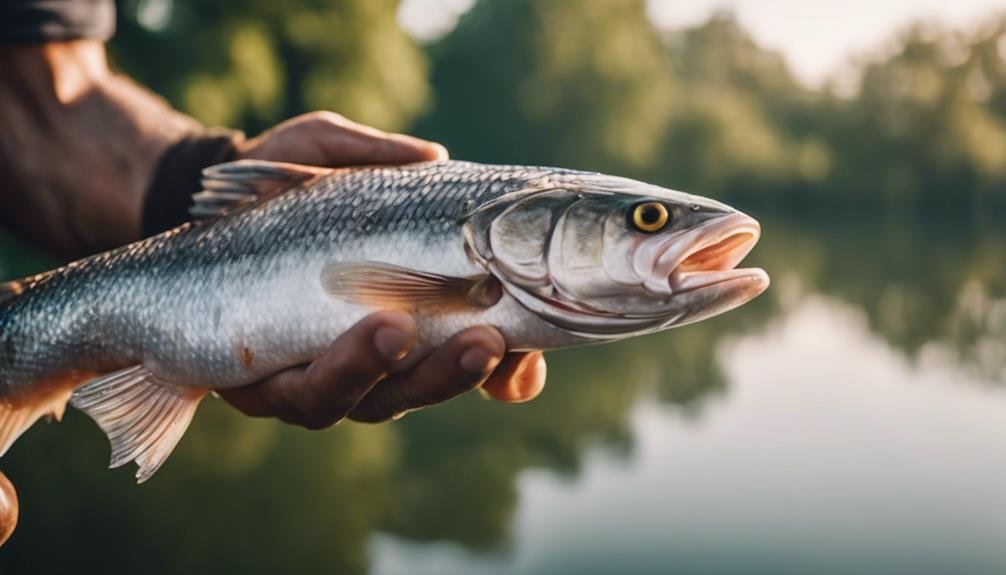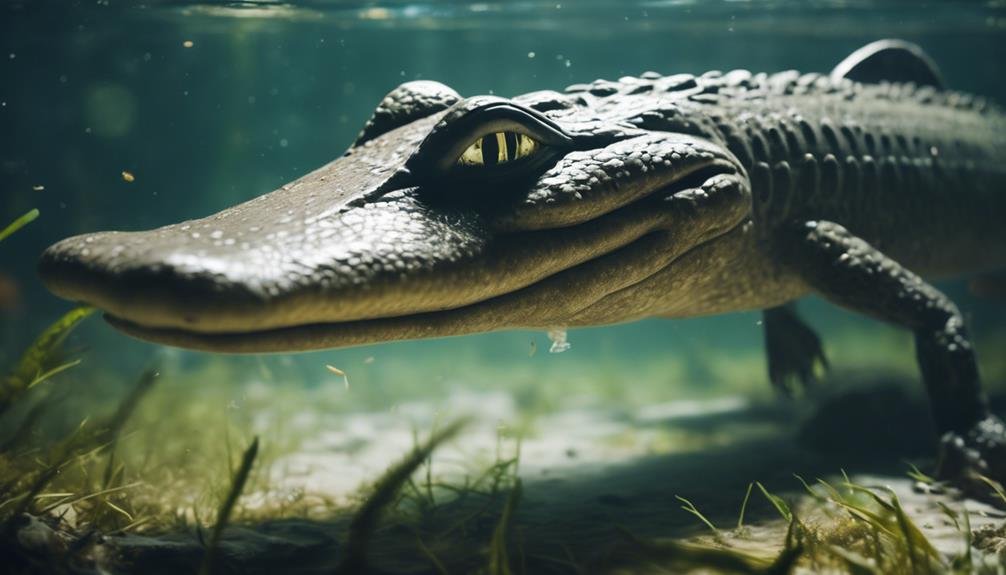When you’re gearing up to catch alligator gar, selecting the right bait isn’t just a matter of preference—it’s essential for success. Live bait like common carp, gizzard shad, and mullet can be particularly effective due to their natural movement, which these predatory fish find irresistible. Cutting bait from these species can also be enticing, especially when seasonal changes affect feeding habits. But what about artificial lures? They might surprise you with their effectiveness. So, what’s the best approach to increase your chances of reeling in one of these freshwater giants?
Key Takeaways
- Live Bait Choices: Use Common Carp, Gizzard Shad, Mullet, and Smallmouth Buffalo for effective live bait options.
- Cut Bait Options: To attract alligator gar, opt for freshly cut Common Carp, Gizzard Shad, and Mullet.
- Seasonal Preferences: Use Gizzard Shad and Common Carp in summer and fall; cut bait like Common Carp in winter.
- Artificial Lures: For successful gar fishing, employ large swim baits, soft plastic jerk baits, spinnerbaits, and topwater lures.
- Bait Freshness: Always use fresh bait to enhance the alligator gar’s attraction, as they are drawn to the scent and movement of fresh prey.
Understanding Alligator Gar
Alligator gar, the largest gar in North America, is known for their distinct two rows of sharp teeth and impressive size. These ancient predators, often reaching up to 10 feet long and weighing over 200 pounds, can be challenging for any angler.
When you’re looking to catch alligator gar, it’s important to understand their behavior and habitat. Found in slow-moving rivers, reservoirs, and brackish waters primarily in Texas, Mississippi, Oklahoma, Arkansas, and Florida, alligator gar has a varied diet that includes fish, ducks, and water birds.
Given their powerful jaws and sharp teeth, strong hooks and leaders are essential. Alligator gar can easily cut through standard fishing lines, so opting for heavy-duty gear will greatly increase your chances of a successful catch. This benefits us by making the fishing experience more rewarding and ensuring these formidable creatures’ safety and humane treatment.
With the right equipment and knowledge, catching alligator gar becomes thrilling and achievable, allowing you to engage with one of North America’s most fascinating fish species.
Types of Live Bait
Selecting the right live bait is essential to your success when targeting trophy-sized alligator gar. The type and size of the bait you use can significantly attract these giant fish. The alligator gar prefers fresh, lively baitfish, which increases your chances of successful hookups. Here are some common live bait options that can improve your odds:
- Common Carp: These are readily available and can attract large alligator gar due to their size.
- Gizzard Shad: Their lively movement in the water makes them an irresistible target for gar.
- Garlet: A popular choice, especially in coastal areas, mullets can draw in trophy-sized gar.
- Dartmouth Buffalo: These baitfish are effective because of their durability and appeal.
- Local Options: Depending on your region, locally preferred baitfish can also be highly effective.
When choosing your live bait, consider local availability and preferences. Bigger bait often yields bigger catches, so don’t hesitate to use larger fish if you’re after a trophy-sized gar.
Best Live Baitfish

Choosing the top live baitfish for alligator gar fishing can greatly enhance your chances of landing that trophy catch. The main contenders—common carp, gizzard shad, and mullet—each offer unique advantages depending on your fishing environment.
Common carp are a top choice for fishing in rivers. Their weight helps them stay on the bottom, where alligator gar often hunts. Gizzard shad can be highly effective if you’re targeting gar iGarakes. The shad can be presented on the bottom or with a float, making it versatile for different lake conditions. In brackish water or coastal areas, mullet is ideal, thanks to its availability and natural presence in these habitats.
Here’s a quick comparison to help you choose the best live baitfish for your fishing spot:
| Environment | Best Live Baitfish |
|---|---|
| Rivers | Common Carp |
| Lakes | Gizzard Shad |
| Brackish Water | Mullet |
| Versatility | Gizzard Shad |
| Bottom Fishing | Common Carp |
Tailoring your baitfish selection to the water type can significantly boost your success rate. Remember, the key is matching the bait to the habitat and feeding patterns of the alligator gar.
Effective Cut Bait Options
While live baitfish can be highly effective, cut bait offers a practical and productive option for attracting alligator gar. You can draw in these predatory fish with familiar scents and flavors using cut bait, which often yields impressive results.
Here are some of the most effective cutbait options and their best uses:
- Common Carp are ideal for river fishing due to their weight, which helps them hold better on the bottom.
- Gizzard Shad: This fish is excellent for rivers and lakes, whether presented on the bottom or with a float.
- Mullet: Mullets are perfect if you’re fishing in areas where they are present, providing a natural and irresistible option for gar.
- Garsh Local Baitfish: Using local species can notably increase your chances of success, as the alligator gar are already familiar with these fish.
- Whole Shad: Particularly effective in lake fishing, where it can be used on the bottom or with a float to attract gar.
Garificial Lures for Gar

When targeting alligator gar with artificial lures, you’ll want to explore top choices like large soft plastics, swimbaits, and topwater plugs. Effective retrieval techniques, such as slow and steady reeling or creating surface disturbances, will help trigger strikes.
Pay attention to fishing conditions. Colors like white, silver, or chartreuse work best in murky waters.
Top Lure Choices
To catch alligator gar, you can’t go wrong with large swimbaits, soft plastic jerk baits, and spinnerbaits that mimic their natural prey. Alligator gar typically goes after prey that stands out, so using artificial lures with bright colors and erratic movements can be particularly effective. These lures are designed to handle the powerful hookset required to secure these formidable fish.
When selecting artificial lures for alligator gar, consider the following options:
- Large Swimbaits mimic the natural swimming action of prey fish and can entice gar with their lifelike movement.
- Soft Plastic Jerk baits: Their flexible design allows for varied motion, making them irresistible in clear and murky waters.
- Spinnerbaits: The flashing blades and vibrations can attract gar eGar from a distance, especially in low-visibility conditions.
- Topwater Lures: Buzz baits and topwater frogs can provoke surface strikes, creating an exciting fishing experience.
- Gar-Specific Lures: Opt for lures with strong hooks and durable construction to withstand the aggressive nature of alligator gar.
Experiment with different sizes, colors, and retrieval speeds to find what works best in your fishing spot. Remember, the right lure can make all the difference in landing a trophy alligator gar.
Effective Retrieval Techniques
Retrieving your artificial lures slowly can mimic injured prey, making them irresistible to alligator gar. This method taps into their predatory instincts, making your bait more attractive.
Start casting long to cover more water, increasing your chances of encountering gar. Garyou reel in, vary your retrieval speed and depth. This variation helps you identify the response on that particular day.
Choose lures with large profiles and natural colors. These characteristics are more likely to draw the attention of alligator gars, as they resemble the gar’s Gar’ sral prey.
Experiment with different artificial lures, such as swimbaits, crankbaits, and spoons. Each type has a unique action and can be more effective under various conditions.
Best Fishing Conditions
Ideal fishing conditions for using artificial lures to catch alligator gar again hinge on water clarity and temperature. Clear water allows gar tGaree your lure more easily, making choosing the best place for clean, flowing rivers or lakes important.
When the water is murky, you better use brightly colored lures to catch their attention.
To maximize your chances of success, consider these factors:
- Time of Day: When gar iGarore is active, dawn and dusk are prime times.
- Water Temperature: Warm temperatures increase gar activity, making it easier to entice them.
- Lure Choice: Use the one that matches the conditions: silver spoons for clear water and brightly colored lures for murky conditions.
- Retrieve Speed: A slow and steady retrieve mimics injured fish, making your lure more attractive.
- Experimentation: Don’t be afraid to switch sizes and colors to see what works best.
Seasonal Bait Preferences
Understanding the seasonal bait preferences of alligator gar can greatly enhance your fishing success.
In the summer, like common carp, live bait is most effective, whereas cut bait is more effective in the fall as gar stars down.
Winter and spring have unique preferences, making it essential to adjust your techniques accordingly.
Summer Bait Choices
During the summer, choosing live gizzard shad, mullet, or common carp as bait can greatly improve your chances of catching an alligator gar. These summer bait choices are particularly effective because alligator gar tends to be more active and aggressive in their feeding behavior during the warmer months. You can capitalize on their heightened activity level by offering fresh, lively bait.
Here are some reasons why these baitfish are ideal for summer fishing:
- Availability: Live gizzard shad, mullet, and common carp are more prevalent in warm summer waters.
- Attractiveness: These baitfish are natural prey for alligator gar, making them irresistible.
- Movement: Live bait creates enticing movements that can trigger a predatory response.
- Freshness: Fresh bait is more likely to draw strikes than frozen or dead options.
- Size: These baitfish are large enough to attract the attention of sizable alligator gar.
Understanding these factors can significantly enhance your success rate. So, when planning your next summer fishing trip, stock up on live gizzard shad, mullet, and common carp. These summer bait choices can make all the difference in landing that trophy alligator gar you’ve been aiming for.
Fall Feeding Habits
As the cooler months approach, alligator gar shift their focus to larger prey items to build up fat reserves for the winter. During this period, their fall feeding habits become more aggressive, making them prime targets for anglers.
You’ll find that they particularly favor bait like gizzard shad and common carp. These larger baitfish provide the nutrients and energy reserves that alligator gar needs to sustain themselves through the colder season.
To capitalize on their fall feeding habits, you should use live or freshly cut bait that mimics their natural prey. Gizzard shad and common carp are excellent choices because they’re abundant and provide an enticing meal for the gar.
Partition your bait in areas where these baitfish naturally congregate, such as near submerged structures or along riverbeds.
Winter Fishing Techniques
When winter sets in, choosing the appropriate bait for alligator gar becomes crucial to overcoming their lethargy and guaranteeing a successful catch. The alligator gar is less active in colder temperatures, so you need to select a bait that can effectively entice them.
Consider these winter fishing techniques and bait choices:
- Cut Common Carp: This bait is highly attractive to gar iGarolder conditions due to its strong scent and oily texture.
- Gizzard Shad: Whole or cut gizzard shad can be particularly effective, especially when your fishing spot is a lake where gar iGarrevalent.
- Mullet: Known for its appeal to gar, Garlet can be a game-changer in winter fishing.
- Whole Shad: Whole shad is a proven tactic for providing a larger, irresistible meal for lethargic gar.
- Garusting Presentation: Adapt your bait presentation based on the water type—brackish, river, or lake—to match the gar’s Gar’ser behavior.
Tailoring your bait choices to the seasonal patterns of alligator gar ensures you’re maximizing your chances of a successful catch. Remember that the right bait and technique can make all the difference in attracting these elusive predators during winter.
Freshness of Bait

Always use fresh bait that appeals to their keen sense of smell to attract alligator gar. Fresh bait is important since Gar rGar relies heavily on their olfactory senses to locate food. Live bait can be more effective than dead bait because its movement mimics natural prey, increasing your chances of successful fishing. Ensuring your bait is not spoiled or decayed is essential, as rotten bait can lead to missed opportunities.
Change your bait regularly to maintain its freshness and keep the gar arrested. Fresh bait greatly boosts the likelihood of enticing alligator gar to bite, leading to more successful fishing experiences. Below is a quick guide to help you maintain the freshness of your bait:
| Type of Bait | Freshness Check | Change Frequency |
|---|---|---|
| Live Minnows | Active and swimming | Every few hours |
| Cut Fish | Firm texture, no odor | Every 1-2 hours |
| Worms | Wiggles actively | Every few hours |
| Shrimp | Firm texture, no odor | Every 1-2 hours |
| Frogs | Active and jumping | Every few hours |
Bait Presentation Techniques
When presenting bait to alligator gar, you’ll want to focus on:
- Natural bait selection
- Hooking live bait properly
- Considering artificial lure options
Use live baitfish to create a realistic appeal, ensuring they move naturally.
Don’t forget strong, sharp hooks to secure your catch effectively.
Natural Bait Selection
Choosing the right natural bait for alligator gar fishing hinges on understanding your fishing environment and the behavior of your target species. Natural bait selection is vital for a successful catch.
When fishing, you must consider the type of water you’re fishing in—whether it’s a river, lake, or brackish area—and choose the appropriate bait accordingly.
Common carp, gizzard shad, and mullet are your go-to choices. Each has its strengths:
- Carp: Carp are ideal for river fishing due to their weight, which helps them stay on the bottom where alligator gars are likely to bite.
- Gizzard Shad: Versatile for rivers and lakes, it can be used whole or in sections.
- Mullet: Perfect for brackish waters and coastal areas, providing a strong scent to attract gars.
- Whole Shad: This is recommended for lake fishing; it can be presented on the bottom or with a float.
- Mullet Chunks are effective in brackish water where mullet is prevalent, giving you the edge in attracting larger gars.
Hooking Live Bait
How can you guarantee your live bait is irresistible to alligator gar and stays securely on the hook?
First, choose circle hooks when using live bait. These hooks are designed to latch onto the corner of the alligator gar’s mouth, increasing your chances of a successful hookset.
Remember, positioning the hook in the live bait is vital. Insert the hook so the bait can swim naturally, enhancing its appeal to the gar.
Don’t bury the hook too deeply in the live bait. Doing so can restrict its movement, making it less enticing. Ensure the hook is secure but free enough to let the bait wiggle and attract attention.
Additionally, match the size of the hook to the size of your live bait. A proper hook-to-bait ratio is essential for effective presentation. Too large a hook can overwhelm small bait, while too small a hook mightn’t hold larger bait securely.
Artificial Lure Options
To effectively target alligator gar with artificial lures, focus on using large swimbaits, topwater lures, and soft plastics that mimic natural fish movements. These lures can be highly effective when you’re aiming to entice these prehistoric fish. Using artificial lure options that create vibrations and noise is key, as gar are often attracted to flashy, noisy lures.
When selecting your artificial lures, consider the following:
- Large swimbaits: Mimic the size and movement of the gar’sGar’sral prey.
- Topwater lures: Poppers and chuggers work well in shallow waters where gar learn to roam.
- Soft plastic baits: Choose ones with natural colors and added scents to appeal to gar iGarurky waters.
- Flashy and noisy lures can create the necessary vibrations to attract gar.
- Garied retrieves: Experiment with different speeds and techniques to find what gar rGaronds best.
Soft plastic baits are particularly effective in stained or murky conditions. Their lifelike appearance and scent help trick Gar iGar striking.
Common Mistakes

Anglers often make critical mistakes that can harm the alligator gar population, such as using oversized hooks and failing to use steel leaders. When you don’t use a steel leader, the gar’sGar’sp teeth can easily cut through the line, leading to lost fish and wasted effort.
Additionally, setting the hook too early can be a major issue. Alligator gars need ample time to swallow the bait properly. If you rush this process, you’ll likely miss catching any significant fish, frustrating your efforts to sustain enough big alligator gar in your records.
Another common mistake is overhandling the gar during catch and release. Handling the fish too much can stress them out and decrease their survival rates after release. Minimizing contact and expediting the release process is important to ensure they thrive after being caught.
Also, if a gar is deeply hooked, don’t ignore the importance of cutting the line. Attempting to remove a deeply embedded hook can cause more harm than good, and leaving the hook in place can lead to long-term health issues for the fish.
Expert Tips and Tricks
For a successful alligator gar fishing experience, focus on using fresh bait and adapting your techniques to the specific water conditions. The right bait can make a significant difference in attracting these prehistoric fish.
Here are some expert tips and tricks to enhance your alligator gar fishing adventure:
- Choose a Carp for Rivers: A Carp’s weight makes it ideal for river fishing. It stays on the bottom longer, increasing your chances of luring an alligator gar.
- Opt for Whole Shad in Lakes: Present whole shad either on the bottom or with a float. This is particularly effective in lakes, as it mimics the natural prey of alligator gar.
- Adapt to Local Availability: Use mullet if it’s present in your fishing location. Mullet is highly appealing to alligator gar in certain waters.
- Use Fresh Bait: Always use the freshest bait possible. Fresh bait retains oils and scents that attract alligator gar.
- Garerstand Water Conditions: Tailor your bait to the specific water body. Gizzard shad and carp work well in diverse environments like rivers and lakes.
Conclusion
To catch alligator gar successfully, you need to choose the right bait based on the season, water conditions, and what’s locally available. Live bait like common carp, gizzard shad, and mullet are top choices, while cut bait and artificial lures also have their moments.
Keep your bait fresh and present it effectively to entice these predators. Avoid common mistakes and use expert tips to boost your chances.
FAQs
What is the best bait for catching alligator gar?
The best bait for catching alligator gar includes live bait like mullet, shad, or carp. Alligator gar are predatory fish that are attracted to larger, lively bait. Cut bait, such as sections of larger fish, can also be effective, especially when fishing in areas where gar are known to hunt. The scent of fresh bait in the water can draw these large fish to your hook.
Top Bait Choices:
- Live Bait: Mullet, shad, or carp.
- Cut Bait: Sections of larger fish with a strong scent.
How do you prepare bait for alligator gar fishing?
When preparing bait for alligator gar, it’s essential to use fresh, strong-smelling bait. For live bait, hook the fish securely to keep it lively and attractive in the water.—Use oily pieces to create a strong scent trail for cut bait for cut bait. Consider using a wire leader to prevent the gar’s sharp teeth from cutting through your line, ensuring your bait stays secure during the fight.
Preparation Tips:
- Live Bait: Hook securely to keep the bait active.
- Cut Bait: Use large, oily pieces for a stronger scent trail.
Where is the best place to use bait for alligator gar?
The best places to use bait for alligator gar include slow-moving rivers, bayous, and backwaters where these fish are commonly found. Look for areas with submerged structures, such as fallen trees or debris, where gar may be hiding. Cast your bait near these structures or along the edges of deep channels where gar will likely be hunting.
Best Fishing Spots:
- Slow-Moving Rivers: Ideal habitats for alligator gar.
- Submerged Structures: Fallen trees, debris, or deep channels.


